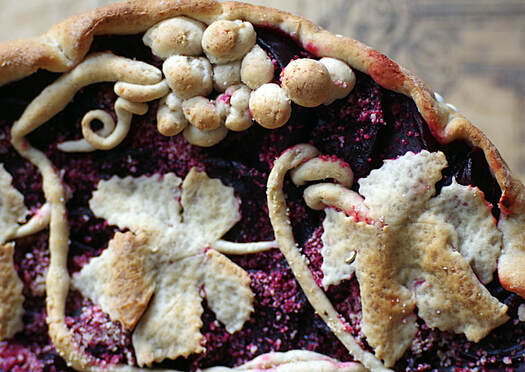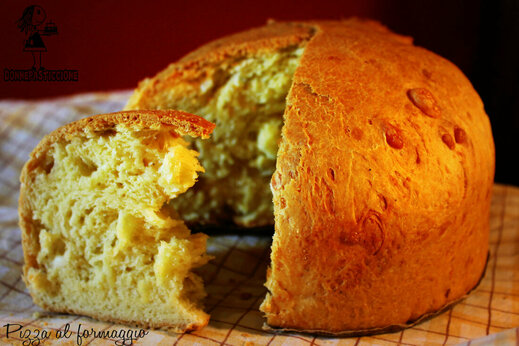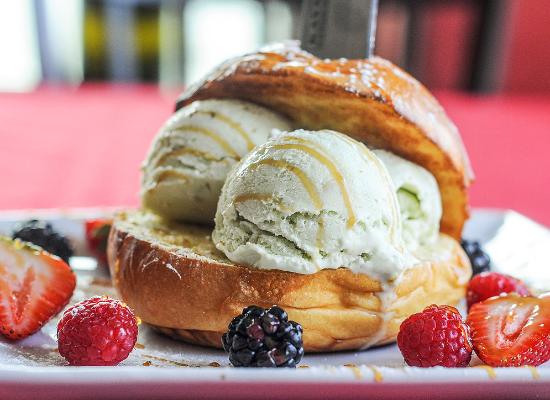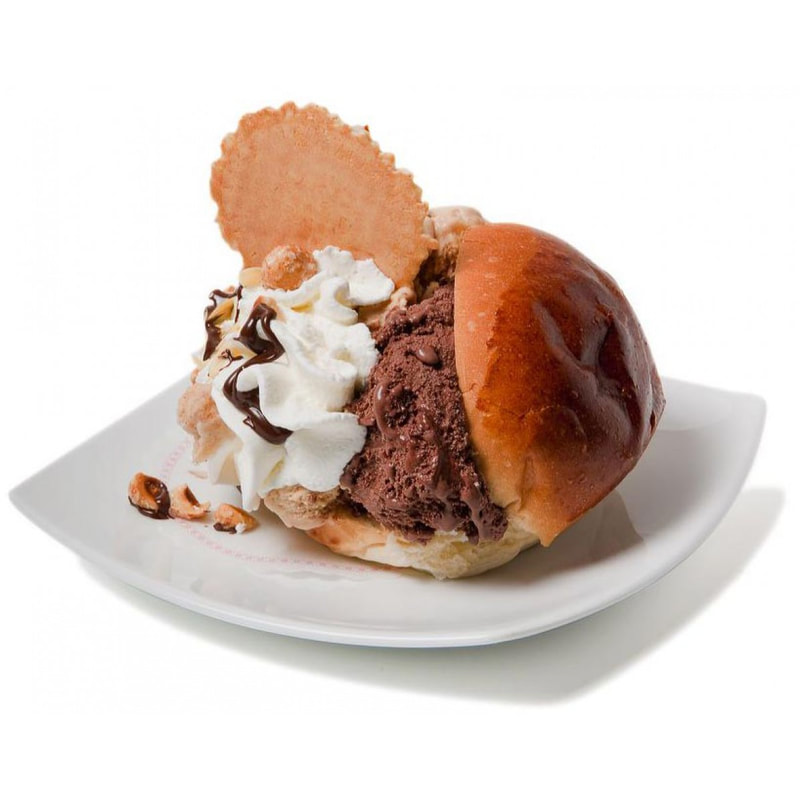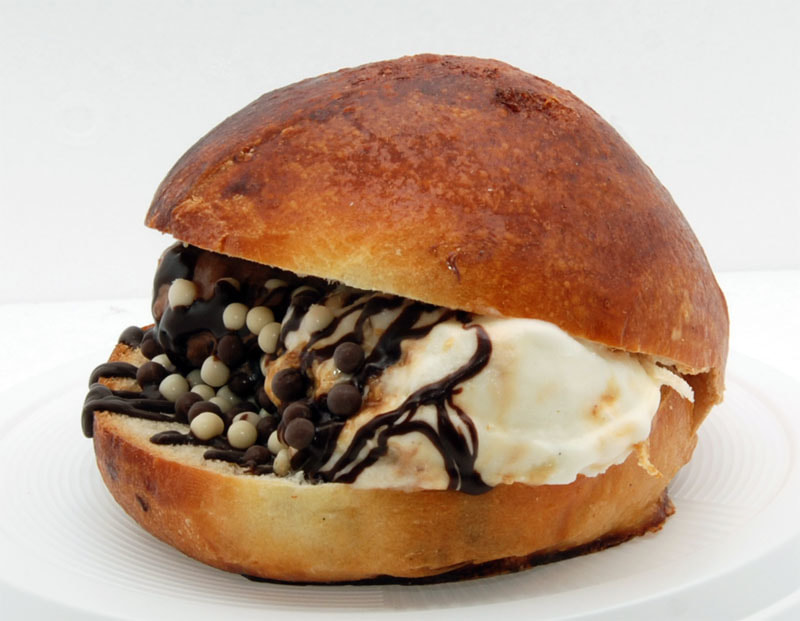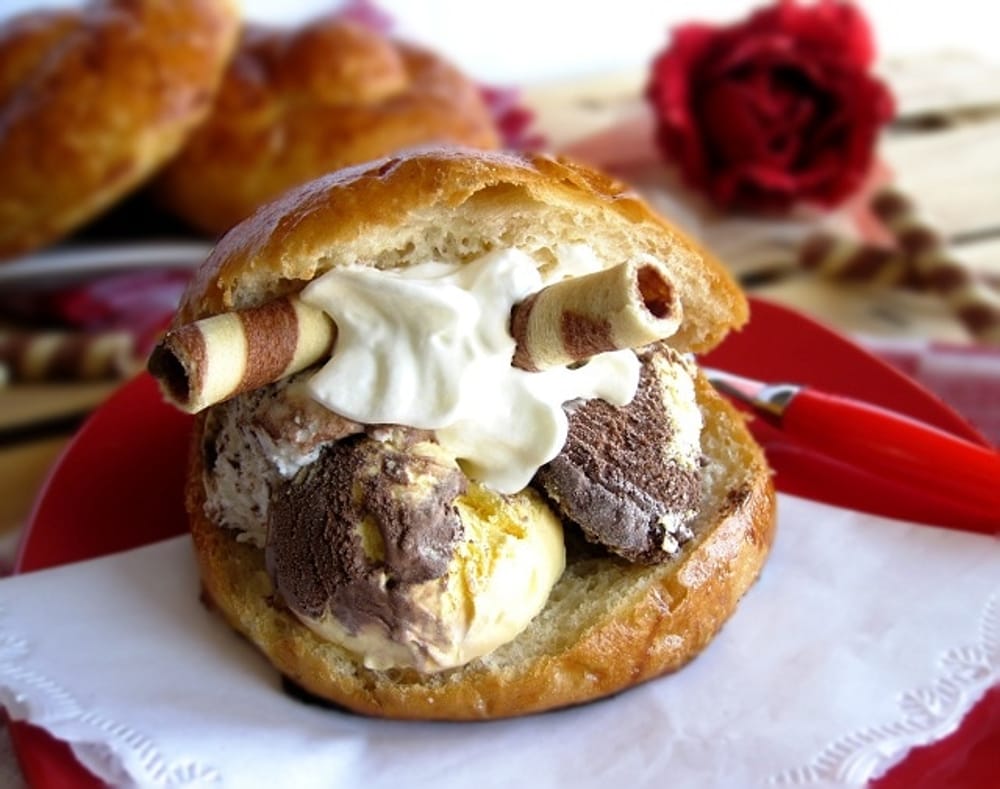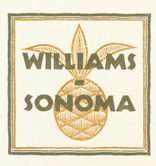|
Without a doubt, one of the best ways to discover truly authentic Italian recipes is to subscribe to Pasta Grammar's YouTube channel. Follow them on social media too... @PastaGrammer. You see, aside from the nonnas on the Pasta Grannies YouTube channel, this raven haired Calabrese, Eva is one of the best cooks who uses traditional techniques for traditional Italian dishes. Her recipe for ciabatta is one you'll want to make every week. --Jerry Finzi  Natale a casa Finzi Natale a casa Finzi Since my son Lucas was small, we have obviously dedicated early Christmas morning to opening gifts. This early morning sharing of love for each other has often stretched past noon, depending on the number of gifts to open. Admittedly, "We Three" (as we call our little famiglia) spoil each other, with multiple gifts and overstuffed stockings hanging on the mantle--some gifts even celebrate Italian cuisine. (This year, my favorite was a 5 pound caciocavallo cheese from Puglia!). This can be a long ordeal (when Lucas was little, it might take all day), so one tradition we've tried to keep is making my recipe for cinnamon-raisin and walnut buns the day before so we can easily heat them up and ice them for our Christmas breakfast. There's nothing better than one of these buns with a hot chocolate on Christmas morning. It's also a quick, simple breakfast to make that won't delay the opening of gifts. Here is the recipe, which can make enough to enjoy throughout the entire Natale season... 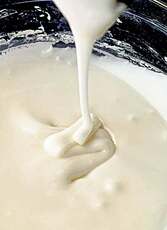 Babbo Finzi's Raisin-Cinnamon-Walnut Buns This recipe makes about 18 buns, about 5" across Ingredients Dough 4 Large Eggs 1 cup warm water (105-110 F) 1/2 cup orange juice 1/4 cup mild honey (Acacia honey is best) 2 tablespoons active dry yeast 7-1/2 - 8 cups all purpose flour 2 teaspoons fine sea salt (I use Baleine brand) 2-3 tablespoons ground cinnamon (to taste) 1-1/2 cups (3 sticks) unsalted butter, at room temperature (cut into pieces) For the Filling 1-1/2 cups light brown sugar 2 cups chopped walnuts (ground in a spice grider) 1/2 teaspoon salt 1/3 cup ground cinnamon 1/2 cup (1 stick) melted, unsalted butter 1-1/4 cups raisins (soaked in an orange liquor for 15 minutes, then drained) For the Frosting 4 cups sifted confectioner's sugar 1 teaspoon vanilla 1 teaspoon Fiori di Sicilia flavoring pinch of salt 2-3 tablespoons orange juice, or orange liquor. 1/4 cup milk (I use skim) grated zest of 1-3 oranges (depending on how many are being served) for sprinkling over the top... I forgot this Christmas) Directions for Dough 1. Place the eggs into a medium bowl and whisk until foamy. 2. Add the warm water and honey to the eggs and mix well to dissolve. Sprinkle the yeast into the egg mixture, stirring well, then let sit to "proof" until foamy (about 10-15 minutes). 3. After the yeast has proofed, add the 1/2 cup of orange juice and stir well. 4. Sift together the 7-1/2 cups of flour, 2-3 teaspoons cinnamon and 1/2 teaspoon salt into the bowl of a stand mixer. 5. Start mixing on a low speed while adding the pieces of room temperature butter until it gets to a rough crumb stage. 6. Make a well in the center and pour in the proofed egg/yeast mixture. Mix on low speed until the dough clears the sides of the bowl. 7. Place the dough onto a lightly floured work surface and knead until it becomes smooth and springs back a bit when a finger is pushed into it. This dough should become smooth and not sticky. 8. Cover with a cotton towel or plastic wrap for 10-15 minutes to relax. Make the Filling 9. In a medium bowl, combine the brown sugar, chopped walnuts, salt and cinnamon. I grind the walnuts into a crumb using a spice grinder, but if you them chunkier, leave them chopped (from a package) or use a chef's knife to chop to a size you like. Filling and Rolling the Dough 10. Prepare two half sheet pans by lining them with parchment paper. 11. Roughly shape the dough ball into a rectangular block to make rolling out into a rectangle easier. On a lightly floured surface, roll out the dough into a rectangle that is no more than 12" and no less than 1/4" thick. The rectangle should be about half as wide as it is long. Try to create 90 degree, angled corners. 12. Using a pastry brush, coat the entire surface of the dough with the melted butter, coming to within 1/4" of all sides. 13. Spread the walnut filling evenly across the dough. 14. Drain the raisins well and spread evenly across the dough. 15. Roll up the dough, starting from the side furthest from you, jellyroll fashion. As you roll toward you, lift occasionally to tighten the roll as you go. When you get to the end, pull and then pinch the last side along its length, pinching the dough so it sticks to itself. 16. Roll the pinched edge so it's underneath your roll. (This helps to hold it in place while cutting.) Using your flat hand or a bench scraper, make sure the ends are pressed in flat. 17. Using a large, serrated bread knife, start cutting 1/2 - 3/4" thick slices, placing each one on your parchment lined sheet pans. You can either allow 1-2" of space between each so they sell into nice round buns (photo below), or more tightly next to each other to create more of a pull-apart bun experience. (See the photo above). 18. Cover the pans loosely with plastic wrap and allow to rise at room temperature, away from drafts, for about 1 hour, or until doubled in bulk. This dough really puffs up! 19. About 30 minutes before baking, preheat oven to 350 F. 20. Place trays on center rack(s) and bake for 15-20 minutes, or until lightly golden brown. You can bake each pan separately, or if your oven can accommodate two pans at once, bake them at the same time, perhaps swapping racks and rotating pans once halfway through baking to ensure even baking. 21. Try not to over-bake these buns--they can dry out easily if over-baked. You want them warm and soft when served. They freeze well (on a tray in the freezer, then placed into zip-lock bags when rock-hard). They will microwave perfectly (30 seconds or so) the next day (after refrigerated), or heated in an oven from frozen for 10-15 minutes at 350 F. They can be iced right before serving. Making the Icing 22. While the buns are baking you can make the icing. Place the sifted confectioner's sugar and salt into a large bowl, and using a small whisk, combine. Whisk in the vanilla, Fiori di Sicilia and the orange juice (or orange liquor). Now, slowly start adding the milk, little by little, until the icing becomes very smooth and can make a ribbon when drizzled from the end of the whisk. You might not need all the milk, or you might need a tablespoon or two more (it depends on the humidity). This recipe can also be made swapping out the milk for water if you are lactose intolerant. You want the icing to be able to drizzle ribbons onto your buns, yet be sticky enough to cling well. Serving/Reheating 23. When finished baking, remove the pans from the oven and let cool for 5-10 minutes right in the pan. If you ice them while hot, the icing might soften and become too thin. 24. Select the buns you want to eat right away and either use your whisk or a small spoon to drizzle lines of icing across the tops. If you like lots of icing, use a small offset spatula and spread a coating of icing across the entire surface. 25. Distribute some orange zest on top. 26. For eating the next day, you can place some buns on a tray (without icing) and cover with plastic wrap. The next day you can reheat the icing for 15 seconds in your microwave, then reheat the buns in the microwave for 30 seconds (using a microwave cover) or in a 325 F oven, lightly covered with foil, for 15 minutes. 27. These buns freeze very well, without icing, by first freezing solid, uncovered, in your freezer until rock hard. Store the frozen buns individually in zip-loc bags. To defrost and reheat, place on a pan covered lightly with foil in a 350 F oven for 15 minutes, then ice afterwards. You can also defrost them using your microwave using the defrost setting, but don't forget to use a cover to prevent drying out. Our buns lasted our family of three from Christmas morning until the Epiphany on January 6th! I hope you enjoy them as much as we do... --Jerry Finzi Copyright 2023 by J.Finzi/GrandVoyageItaly.com
Just in time for the holidays... Autumn Beet Tart!
(Easier to say than Torta d'Autunno con Barbabietola, wouldn't you agree?) For the Crust: 1 cup of all purpose flour 3/4 cup almond flour 3 teaspoons yeast 1/4 cup water 4 tablespoons of cane sugar 2 tablespoons of extra virgin olive oil 1 teaspoon of ground fennel seeds 1 pinch of salt 1 beaten egg For the Filling: 2 large beet roots, steamed 1/2 brown sugar Directions
Celebrate International Women's Day like they do in Italy, or as they call it, Festa delle Donne... with a cake, namely Torta di Mimosa. Easter is called Pasqua in Italy, and is a time for celebration and breaking the Lenten fast. In Italy, spring comes early, the weather is wonderful and the scent of flowers blossoming are everywhere. Pasqua is a time for feasting with la famiglia. The Monday after Easter Sunday is a national holiday called Pasquetta (Little Easter), when most businesses close and workers spend the day at home with their family. There are many types of celebration sweet pane (breads) and savory torte (cakes or tarts) in Italy, many of which made from family recipes handed down from generation to generation--often hundreds of years old. Some are known all over Italy while others are regional or local traditional recipes. One has to keep in mind, however, that even within each region there are variations in these recipes--often changing from town to town or family to family. Just keep in mind, it's all about the feast. Here are some of the more popular treats with links to their traditional Italian recipes. If you need translations you can always cut and paste the text of each recipe into Google Translate (or better yet, install a translation plug-in into your browser to do it automatically). Enjoy... and Buona Pasqua! 
When autumn comes to Tuscany, you will be able to enjoy Castagnaccio, a torta rustica made with chestnut flour and olive oil that has ancient origins. In the 1500s it was well known in Tuscany as cucina povera, a dish prepared by poor, peasant farmers and shepherds. Chestnuts were plentiful in the hills of the Apennines and easy to harvest, not only for its nutritious flesh but also for chestnut flour. Chestnuts (castagne) are rich in protein, calcium and vitamin A.
This torta can also be called baldino, ghirighio, toppone or pattona, depending on where you are in Italy. Local variations may include other ingredients, such as rosemary, orange peel and fennel seeds. There is even one romantic legend that says when its perfumed with rosemary, Castagnaccio is a powerful love potion--making and serving it the object of your affections will make them fall in love with you, and ask for your hand in marriage. Perhaps this is more than just a dish served during Natale, but also appropriate for Valentine's Day! In its earliest conception, it was an easy way to make a portable food (like an energy bar) that stored well for long periods, helping sustain poor contadini during long, harsh winters. According to Ortensio Landi (1553) in his “Commentario delle più notabili et mostruose cose d’Italia e di altri luoghi“ ("Commentary on the most notable and monstrous things of Italy and of other places"), he traced its origins to a man called Pilade from Lucca. By the nineteenth century however, the addition of pignoli and dried fruits morphed this spiced cake into a dessert deserving of the Christmas season and its popularity spread to Liguria, Piedmont and Emilia Romagna and even on the nearby French island of Corsica. Today you will find castagnaccio just about everywhere in Italy during Natale festivities. Keeping with Tuscan tastes, typically, no sugar is added because of the inherent sweetness in the chestnuts themselves and the addition of dried fruit and raisins. Castagnaccio is often served with ricotta, honey or sweet wines such as Vin Santo. 
Ingredients
Optional: You can soak the raisins in rum, Amaretto or orange liquor instead of water for a more adult version.
Directions

Serve with a glass of Vin Santo, and a dollop of fresh ricotta on the side, and drizzle both with a Tuscan honey of your choice.
Buon appetito! --Jerry Finzi
For further reading:
Chestnuts: The Italian Love Affair with Castagne Foto del Giorno: Chestnut Vendor Harvest Festivals in Italy: From Grapes to Wine, and More

We've all grown up with it... That red white and green, Italian flag colored delight sold as little cookie squares in just about every Italian (and non-Italian) across the United States and Canada. Called a Rainbow Cookie, often called Tricolore because of its resemblance to the Italian flag, and sometimes called Seven Layer Cookies (3 cake, 2 chocolate and 2 jam). Although some say they don't exist in Italy, they do appear in Italian pasticcerie, usually around Christmastime--their red and green colors accenting the holiday cheer. They are also referred to as Venetians, a nod toward the fact they are more pastry than cookie.
They look like a throwback to the psychedelic, tie-dyed days of the 1960s. Topped (and bottomed) with a layer of chocolate, each colored layer flavored with almond paste, with thin coats of apricot or raspberry jam in between, who can resist buying a string-tied, neat little white box of these little dolci? For a couple of decades now, even supermarkets, delis and big box stores like BJs and Costco are offering factory-baked versions of them... it's become one of the more popular, year-round cookies in America, but it's especially popular at Christmas because of the holiday colors.
I recently spoke to Robert Zerilli of Veniero's Pastry shop on the lower east side of Manhattan, an historic Italian bakery famous for many types of pastries. Robert is the great, great nephew of their founder, Antonio Veniero who started the bakery by making biscotti in a former pool hall in 1894.
Commenting on the history of the rainbow cookie, "As for the history of the rainbow cookie I believe it’s representative of the Italian Flag and the United Kingdom of Italy as a country instead of independent Provinces. My father would give me a rainbow cookie when I visited as a child in the mid 60’s and all of our family enjoyed eating them as well." Veniero's makes about 300 lbs of these colored morsels each month, with about 15 cookies in each pound. That number increases around the holidays, Zerilli claims proudly, "So each year, we produce about 3000-3500 lbs!". Veniero’s "Authentic Rainbow Cookie" definitely stands out as one of the best that's enjoyed by folks all over the world.
Italian? Rainbow? Cookie?
First of all, it's not really a cookie. It's more of a triple-layer sponge cake, although some bakeries put so much almond paste into their sponge that they really aren't "cake" any more! They are baked in large sheet pans and meticulously cut into those little squares that we all love. I shouldn't say "all" love them, because I have met people who just don't go for almond/marzipan flavors, even if they are presented with a neon, edible rainbow. That's another thing... it's not really a rainbow, which have seven colors. This delightful pastry creation has only three. And while a rainbow comes from white light being broken up by a prism into colors, this cookie has one white layer to start with. Finally, most claim this recipe is not Italian. They say that it is an Italian-American creation, created to honor the Italian flag by Italian-American bakers. I doubted this, so I did some research... In fact, you can find version called Pasticcini arcobaleno (little rainbow pastries) in Italy during the Christmas season. Besides, nearly every "Italian-American" recipe owes its existence to a recipe from mainland Italy. Perhaps the recipe has changed a bit, its core is Italian. I really can't imagine such a complex pastry preparation coming out of American bakeries alone without any historic link to the traditional recipes of the past. 
Click HERE for a very traditional recipe which uses the technique of a heavy weight and chilling to duplicate an authentic result. And unlike some recipes, both sides are coated with chocolate.
Buon appetito! --Jerry Finzi I've never been a big fan of cannoli, but I have to admit, THIS Cannoli tower takes the cake! Great idea for a wedding instead of a typical wedding cake.
--Jerry Finzi Summer is in full swing, and with Italy currently in the midst of a full blown heatwave, here is an idea from southern Italy that will help you beat the heat...
Brioche Gelato Burgers! More and more popular in Sicily, Puglia and Calabria, the trend is catching on. In the last several years, the sweet, glossy brioche bun has gained popularity in the States, used as the go-to bun for burgers and sliders. But the sweet, soft crumb of the classic brioche also pairs well with gelato (OK, and ice cream, too). Grilling the sliced brioche helps raise the flavor a notch. Toppings or spreads can include, crushed pistachios or sliced almonds, Nutella, Pirouettes crackers, almond biscotti crumbs, whipped cream or zabaglione, or a smear of almond paste. How about a trio of gelato sliders? To add crunch, tuck a pizzelle inside! Stay cool! --GVI You know, I always thought I'd have a problem eating weird things if I ever traveled in the Orient. I'm a person with a fairly narrow palate... I admit it. Even my 14 year old, Lucas has a much broader palate than I do. I like what I like and won't try what I know I don't like. I'm old enough to say that I have tried lots of stuff--for instance, I hate caviar and cooked spinach makes me gag. I know what I can't stomach. In my research and travels about Italy, I've come across things that I wouldn't eat if you paid me. Some things I'll try--once--while others... well, you just sort of know to stay clear. Still, we have to respect the culinary traditions of our Italian heritage and try not to be so grossed out by it. Food is fuel--fuel is food. In Italy, nothing goes to waste--not beast or flora. So, I hope you pardon me as I poke a little fun at some of Italy's oddest culinary creations--even though I may tease a bit, I still want to honor the complexities if la Cucina Italiana... In ancient Rome peacock eggs, boiled ostrich and stewed parrots were common on menus.  Stuffed Mice There is a protected, fluffy tailed species of dormice (Glis glis or Ghiro) that have been eaten since the days the Caesars ran things. Down in Calabria the rodents are still stuffed and chomped on. They are stuffed with meat, nuts, raisins, onions and spices. You can imagine little squeaks as you take a bite. I have no idea what they do with all those cute fluffy tails. Ghiri alla pizzaiola : Ingredients : . 2 Ghires, 50 g of lard, 50g of pancetta, gr 600 gr peeled tomatoes, 1 tablespoon of chopped parsley, 1 tablespoon of oregano, 1 tablespoon extra virgin olive oil, 1/2 teaspoon of salt Engage the dormice lengthwise, peel them, quickly remove the bladder without breaking it and leave it in running water for a few hours. Rinse them and blanch in boiling water for a couple of minutes. Chop the lard and the bacon and put the mince in the belly of the dormice. Place them in a large pan, pour the oil and cover with chopped tomatoes, parsley and minced garlic, oregano and salt. Cook over moderate heat, keeping the pan tightly closed with the lid.  Riccota Forte (or Scanta) The Pugliese are a resourceful bunch. I know--mu Dad was from Puglia. Many of you may know that ricotta means twice cooked or re-cooked... basically, ricotta is a by-product of normal, everyday cheese making. You take the little bit of whey left over, add an acid, boil it and presto, you have ricotta cheese. It's a fresh cheese and should be eaten within a couple of days. When it dries out, the frugal Pugliese add salt, and let it dry even more into Ricotta Salada (one of my favorite cheeses). But some go even further. Some just let it go bad... and stinky... and acrid, turning it into a Apulian delicacy called Ricotta Forte, or Scanta. Many think this acrid, foul smelling cheese is worse than any other stinky cheese they've even eaten--but in a good way. We tried it during our stay in trullo B&B outside of Alberobello. Yes, it stinks, and our host told us how it's just kept in a dark, un-refrigerated place (under his sink) to grow more bacteria and even sometimes microscopic worms--but we actually liked it! (But it did burn my eyes a tad).  It's the kind of taste that shocks your eyes open, assaults your nose but somehow in the end pleases your palate. It's also a surprise when you are first introduced to it in a plain jar that looks like it's your Aunt's 1950s era home brew face cream. Enjoy. (Oh, just don't get it on anything sweet... I got it on some Nutella and bread by mistake and nearly got whiplash when I popped it in my mouth.)  Casu Marzu or Formaggio Marcio (Rotten Cheese), with Maggots Casu Marzu is a sheeps' milk cheese from Sardinia and Corsica (they call it Casgio Merzu) that actually contains maggots--live ones. Most cheeses rely on fermentation and bacteria to develop their flavor, but this cheese relies on actual decomposition caused by the Cheese Fly larvae. The texture is an oozing, seeping liquid, essentially caused by... well... maggot poop. Some people eat this stuff with the larvae, some will tickle the cheese, causing the larvae to be disturbed enough to actually jump out... as much as 6 inches! The daring who have tasted it say this muck is so acidic that it leaves an after taste in your mouth for hours afterward. I recall a cheese like this in France years ago--I wouldn't go near that either!  Batarga From what I hear, battarga is definitely an acquired taste that's at least a thousand years old and perhaps more ancient than that. It's made from the roe (fish egg) pouch of either grey mullet or Atlantic blue-fin tuna. The roe pouch is manipulated by hand to get rid of any air bubbles and then cured in sea salt for several weeks. After curing, the result is a hard, dried salty slab which is usually (but not always) coated in beeswax.  To use it, you grate some on top of pasta or on top of crostini (toasted bread) and drizzled with olive oil. It also can be used as a main ingredient along with garlic for tomato sauce. It has a tremendously long shelf life and is often smuggled out of Italy due to its high price--up to $140 a pound! You can actually order some on AMAZON.  Colatura di Alici, Fish Sauce In ancient Roman times there was a fishy concoction called garum, a clear sauce made from salting and compression of various types of fish. The clear garum on top was used by the upper classes, while the sludge left over, called allec, was used by the lower classes to add flavor to polenta, porridge or on bread. Today there is a modern version called Colatura di Alici made in one of my favorite villages on the Amalfi Coast, Cetera (click the photo to see it on Amazon). The first time I took a tour of Cetera at ground level on Google Earth I started seeing barrels and wondered why this village had so many. It's a fairly simple recipe... 
The golden liquid is prized in Italy and is used to flavor all sorts of dishes. Watch the video of Colatura being made... 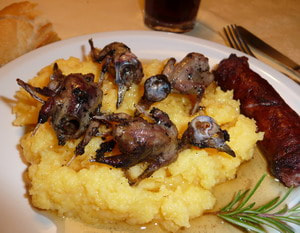 Polenta Uccelli (Polenta with Songbirds, or Polenta e Osei) Yes, the same song birds that will awaken you on a misty Tuscan morning are being shot or captured in hanging nets by hunters to supply their illegal bounty to select restaurants throughout Italy. Yes, it is illegal, but those doing it consider the practice as being furbo (crafty). They make a living while carrying on a tradition. In Tuscany the birds are flambéed, in Sardinia they are boiled and preserved, in the Veneto rolled in pork belly and fried. Perhaps the best known version is in Lombardy where they are grilled or fried. It seems this is an elite recipe item in Italy. Ladies and gents get dressed up in all their finery and make an event out of eating these little skylarks, goldfinches and other types of song birds. Our hot air balloon pilot, Stefano told us they shoot anything in Italy, especially song birds, so much so that some species are becoming endangered. Oddly, we flew directly over some "hunters" in their treetop blind, releasing pigeons only to shoot them a moment or two later. The little tweetys are usually stuffed with pork, beef, rabbit or even other birds. They are served with their heads and beaks on top of polenta, an attempt to mimic a bird's nest.  To illustrate how much Italians love this special dish, certain pasticcerie have created a legal version: a dessert called Polenta e Osei, made to look just like the real dish. It's made of a soft light sponge cake filled with hazelnut cream that is rolled in a yellow fondant. On top are little chocolate birds made from chocolate marzipan. You can find this in the town of Bergamo. As for the real song bird dish, the macho thing is to pick up the birdie by the beak and leave nothing... devouring bones, beak and all. At least they are not as ruthless as a similar dish I saw in France years ago--where they drown the birds in the local brandy, then when eating drape a napkin over their heads and the dish to inhale the fragrances and crunch down on the bird, apparently head hidden in shame.  Pajata (Cheese from Cow's Intestines) This is either a Roman dish or what the Devil himself would order up. A young, milk fed (no grass feed) calf is slaughtered, and besides getting veal, brains and other delicacies from it, the intestines are used to make this delicacy--pajata. The intestines are washed, but not emptied. When cooked, the partially-digested milk inside turns into a thick, funky cheesy substance which is used as a pasta sauce, and often served on its own with crostata. No grazie! 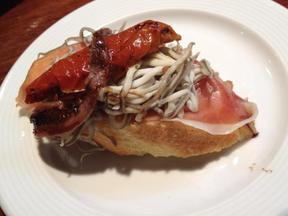 Cieche (Baby eels) Cieche are baby eels that migrate upriver after being born in the sea. The name, Cieche (cieco) literally means blind – these babies have no eyes. In coastal areas of Tuscany, cieche are usually fried or boiled alive. Just be careful they don't jump out when you're trying to dump them into the boiling water or saute pan. 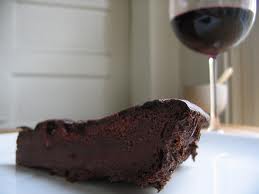 Tuscan Blood Torte Enough said. A torte or cake made from the blood of pigs? I've tried Argentinian blood sausage and British blood sausage, and if the flavor is anything close to what I experienced, I would never go near this stuff. But this recipe contains cocoa and has a chocolate taste, albeit a bit more... er... pungent because of the pig's blood it contains. The pudding used is similar to Sanguinaccio Dolce, a traditional recipe in the South made when a pig is slaughtered using the pig's blood, chocolate, raisins pignoli and sugar. This is an example of the Italian philosophy that nothing goes to waste, not even the last drops of blood. Watch the video below from the Two Greedy Italians series where Gennaro shows how they make the pudding (at 9:45). 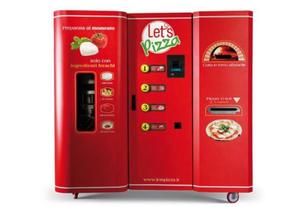 Vending Machine Pizza As all of the above proves, Italians will eat anything... even pizza made totally inside a robotic vending machine. Not THAT's a real crime! Let's Pizza machines were initially designed and manufactured in Northern Italy. It offers a choice of four kinds of pies, and makes the pizza while you watch the whole process through windows--adding water to flour, kneading the dough, placing the sauce and toppings, and baking the pizza via infrared oven in just 2.5 minutes. It can produce 90 to 100 pizzas before it needs to be refilled. Ugh. Just because you can, doesn't mean you should!  Ok, so vending machine pizza isn't such a big deal, but how about (suspenseful music...) Gatto in Umido? This translates as "Stewed Cat"! Calmati, Betty White... "Gatto in Umido" is simply Stewed Cat-Fish. As I said, we all have to keep an open mind. I hope you enjoyed this look into the traditions of culinary Italy. Via la Cucina Italiana! --Jerry Finzi |
Archives
May 2024
Categories
All
|



